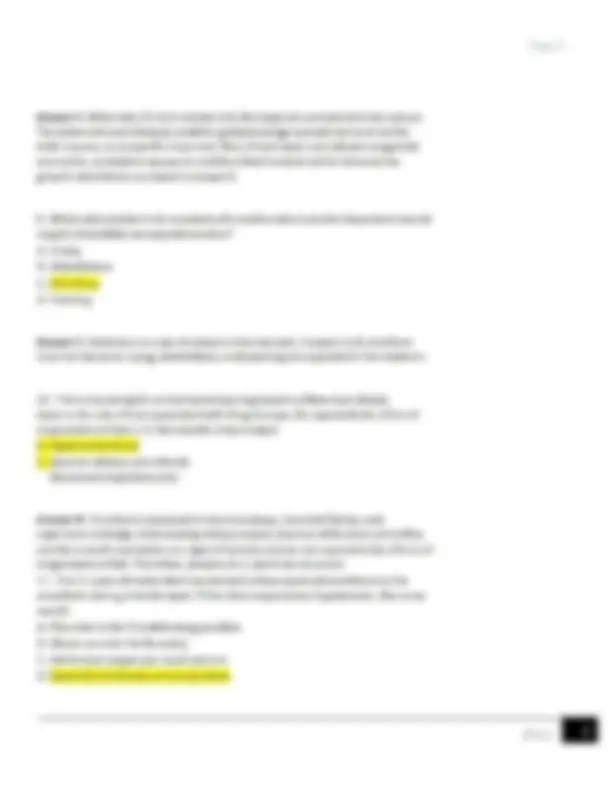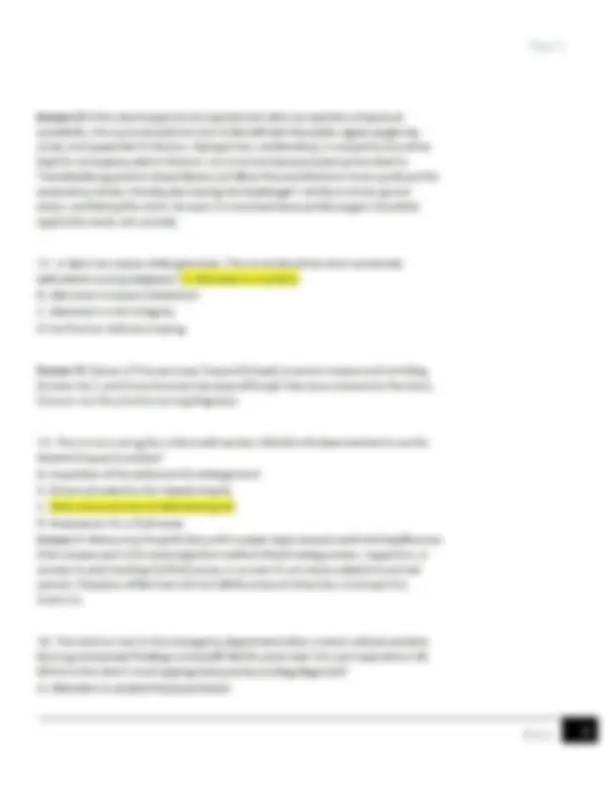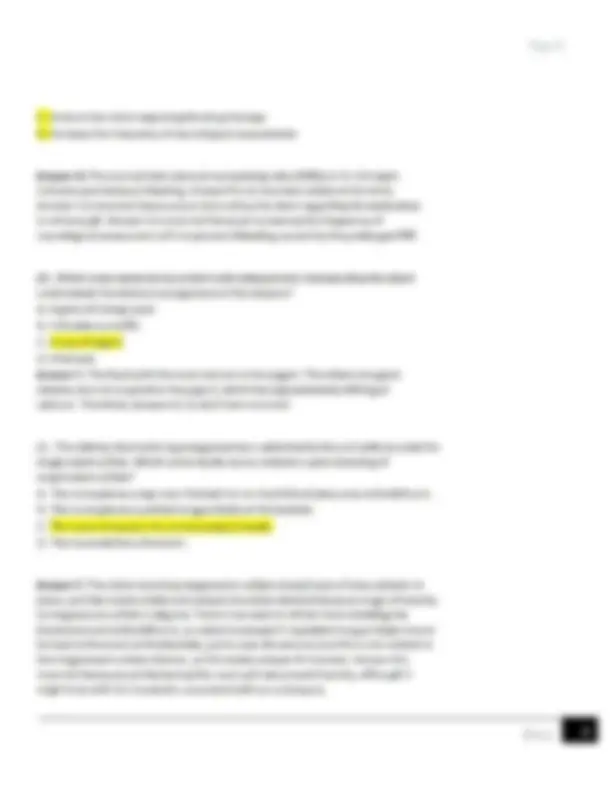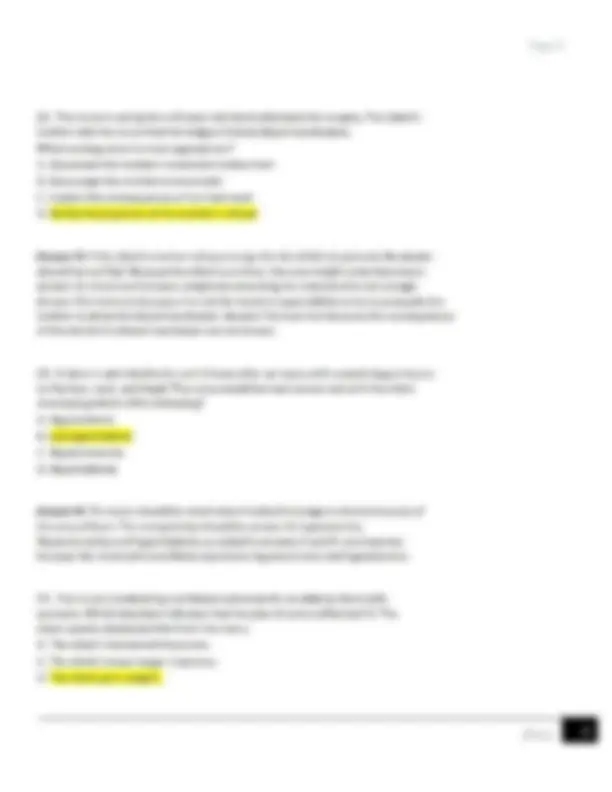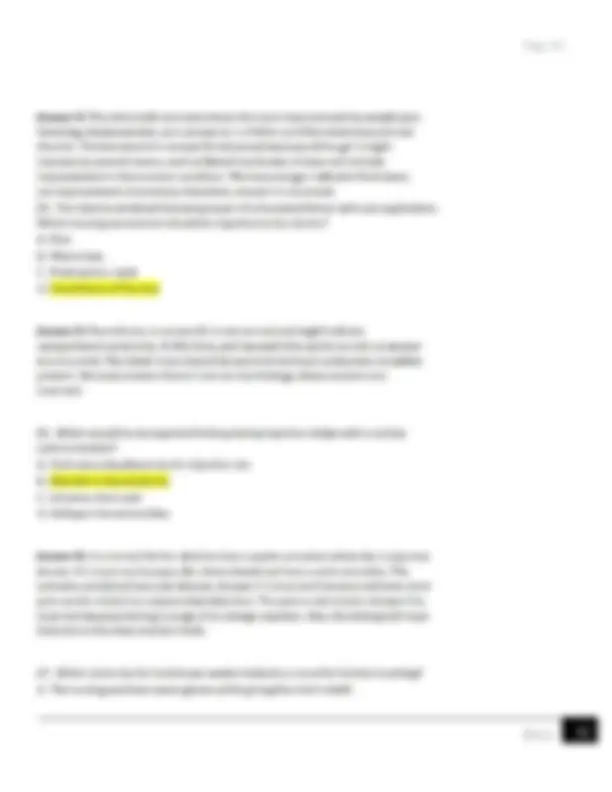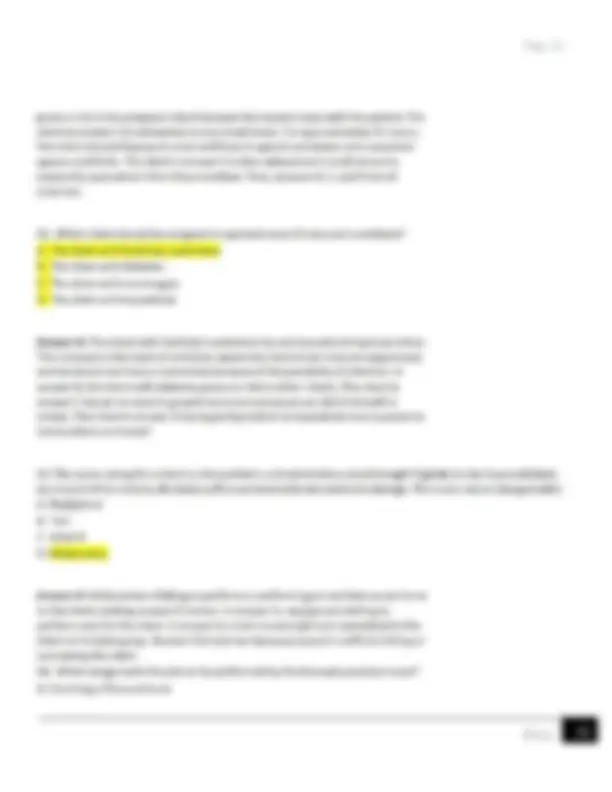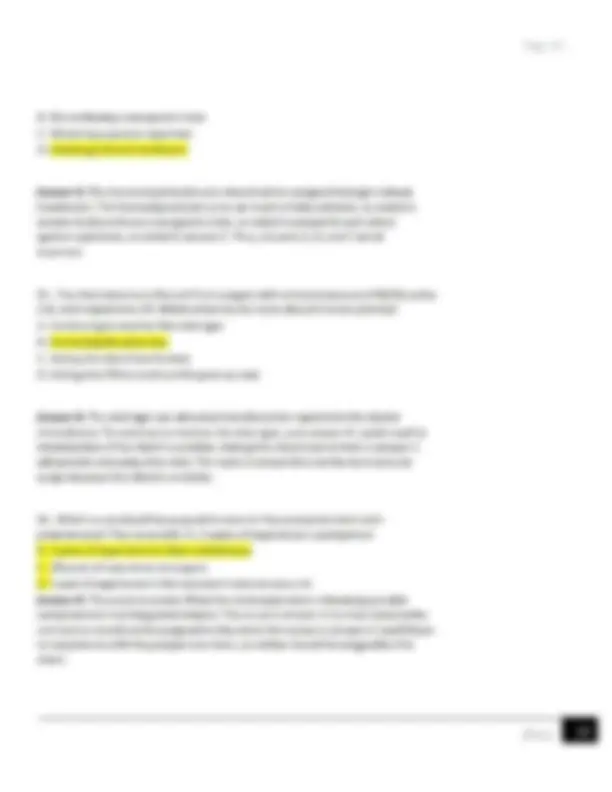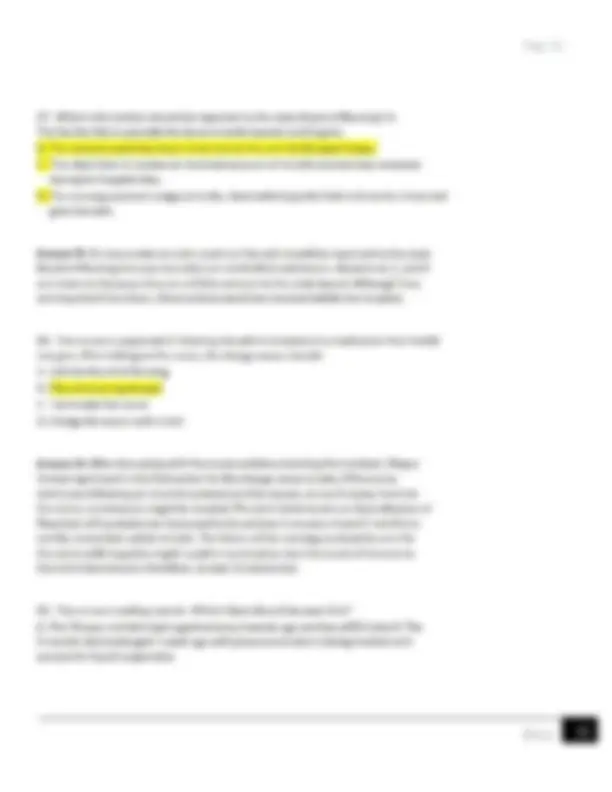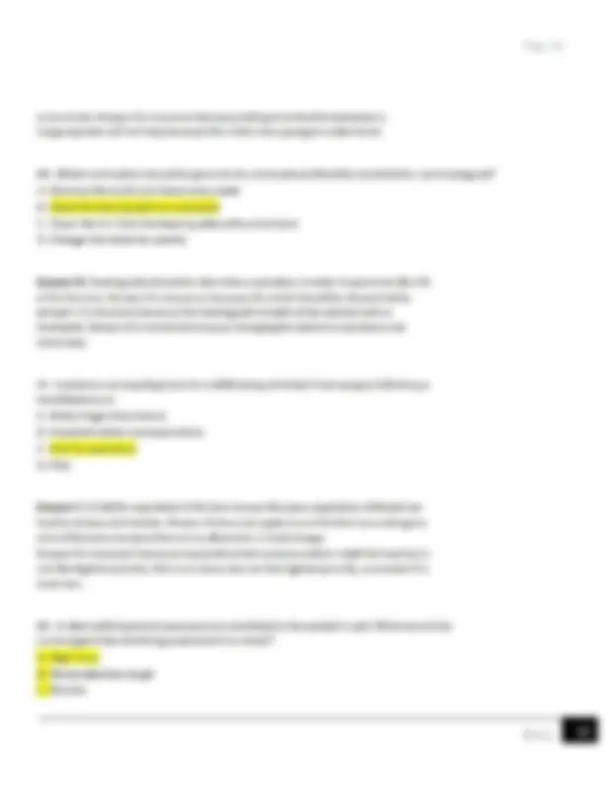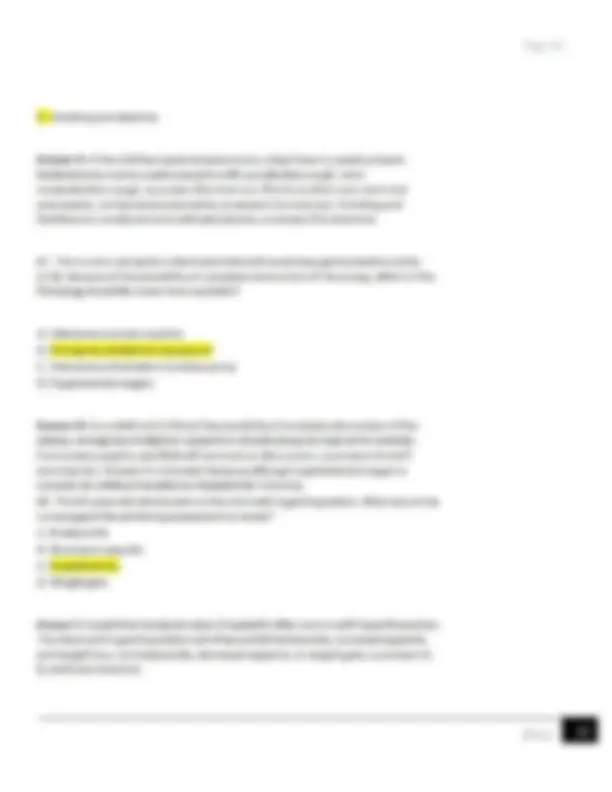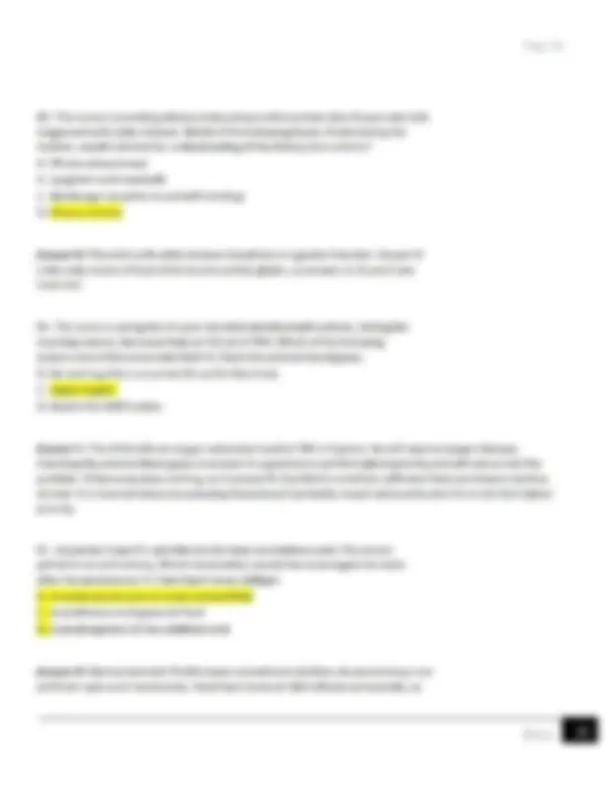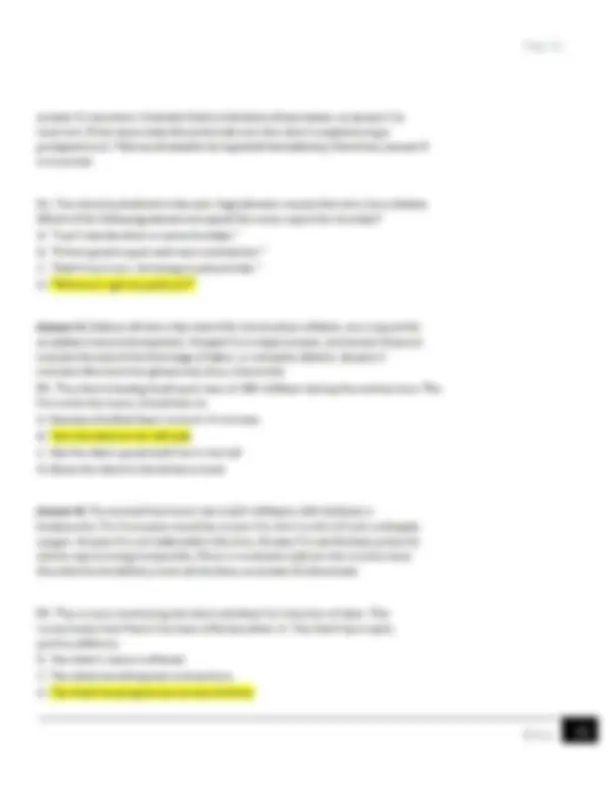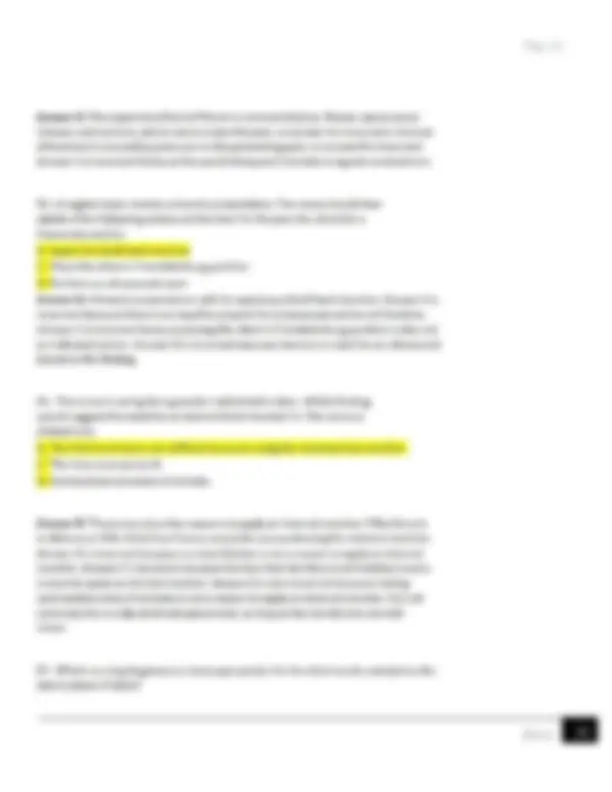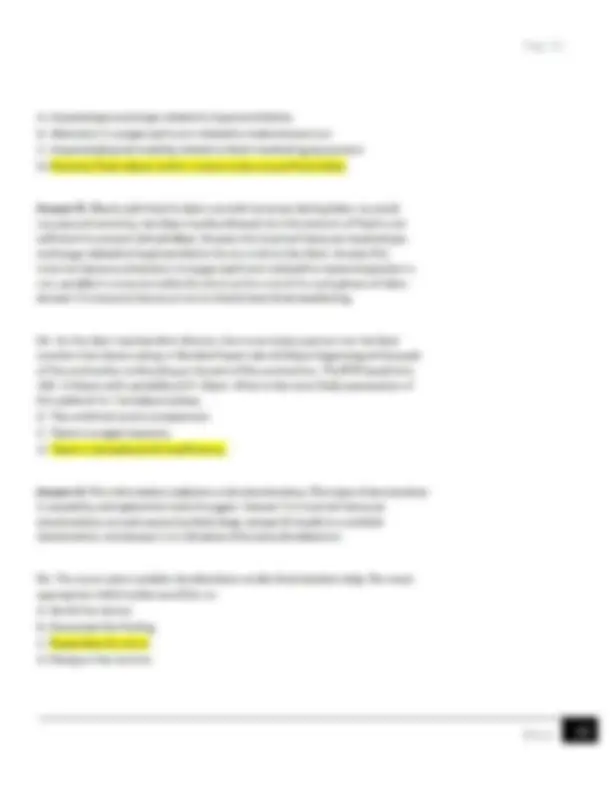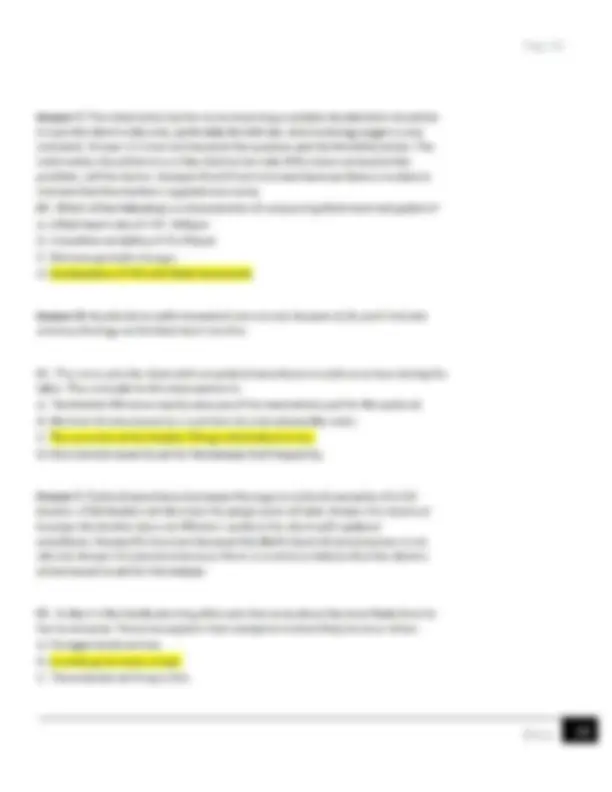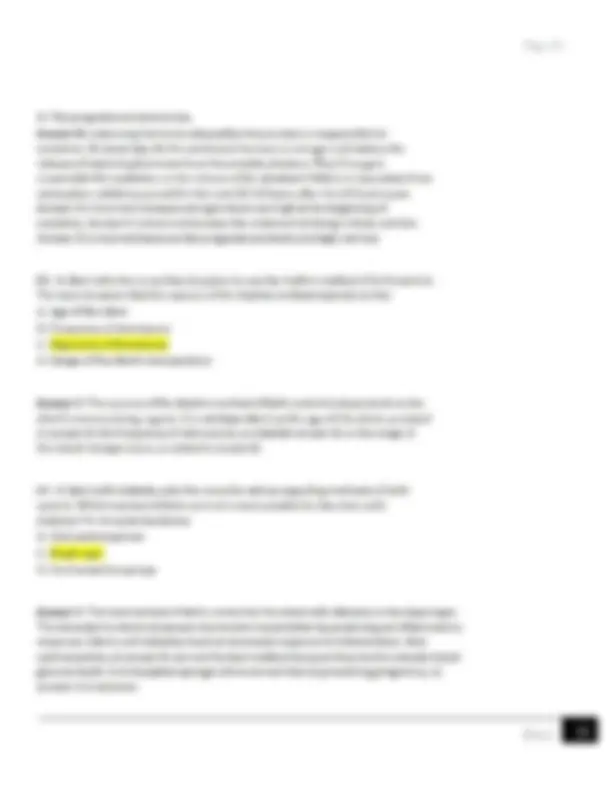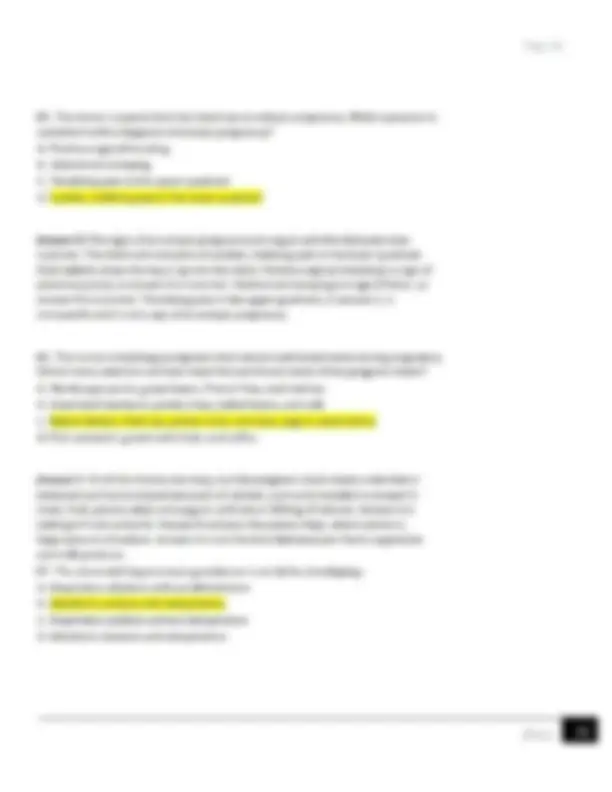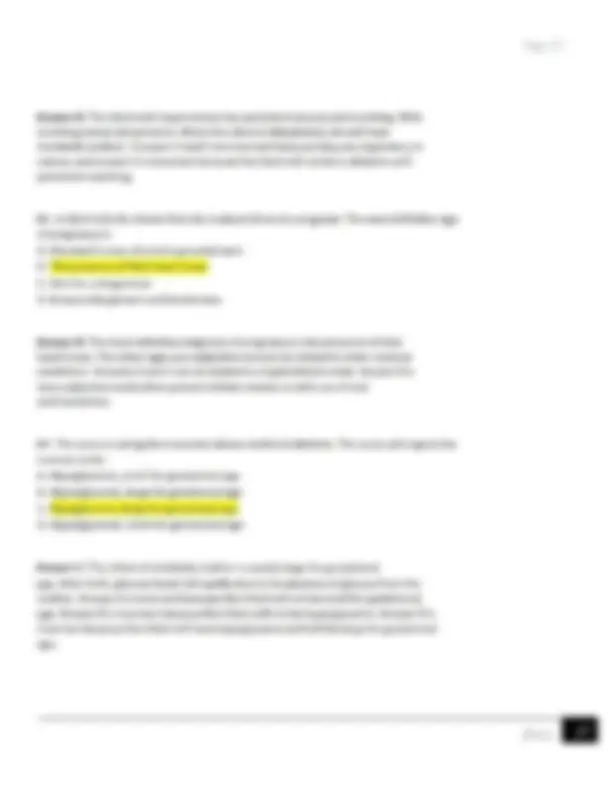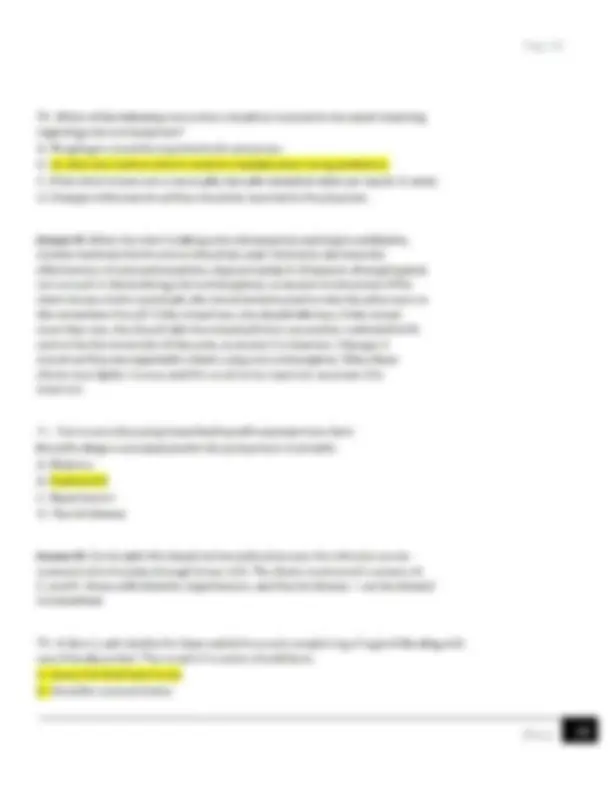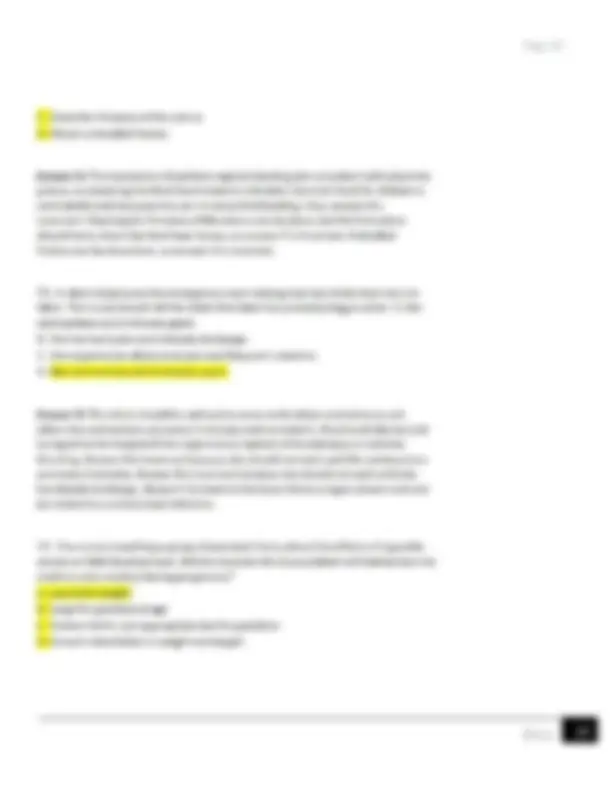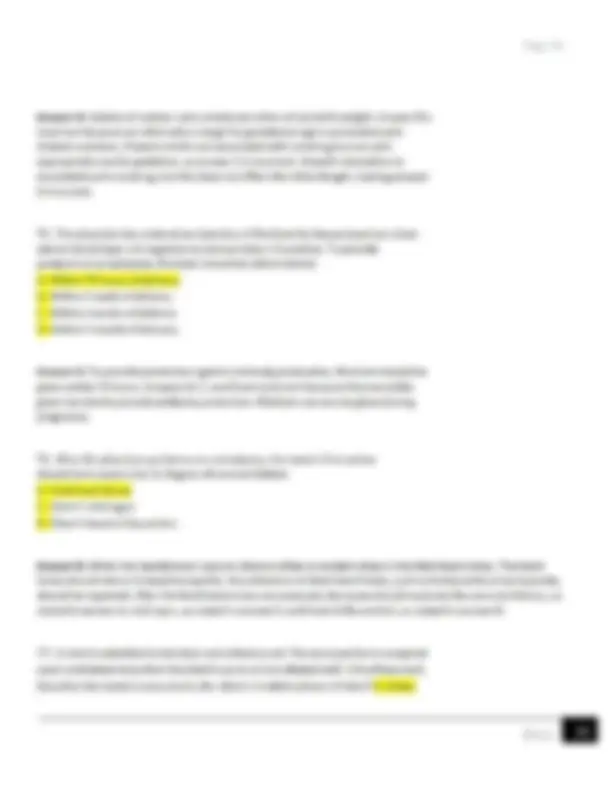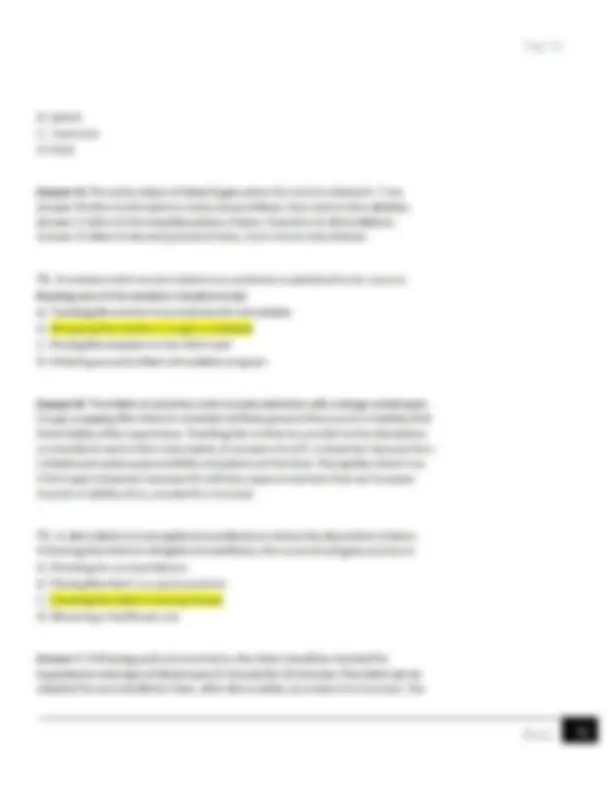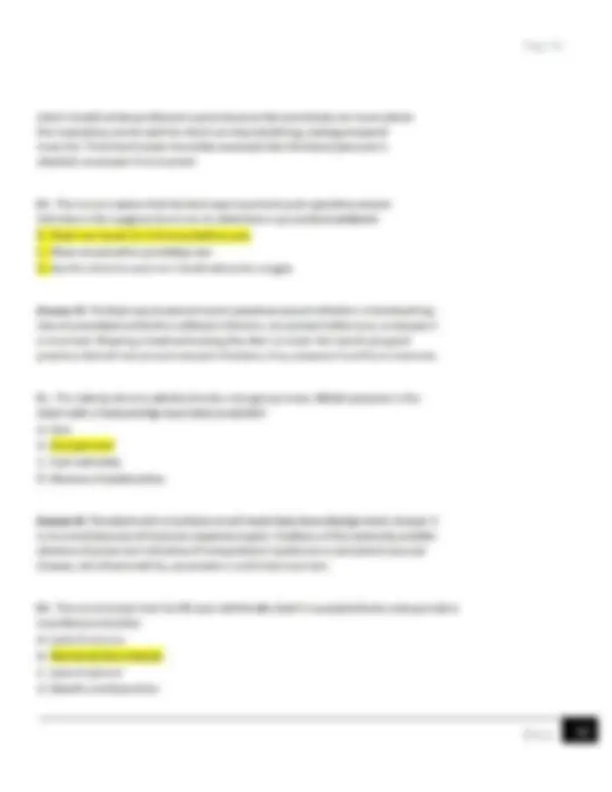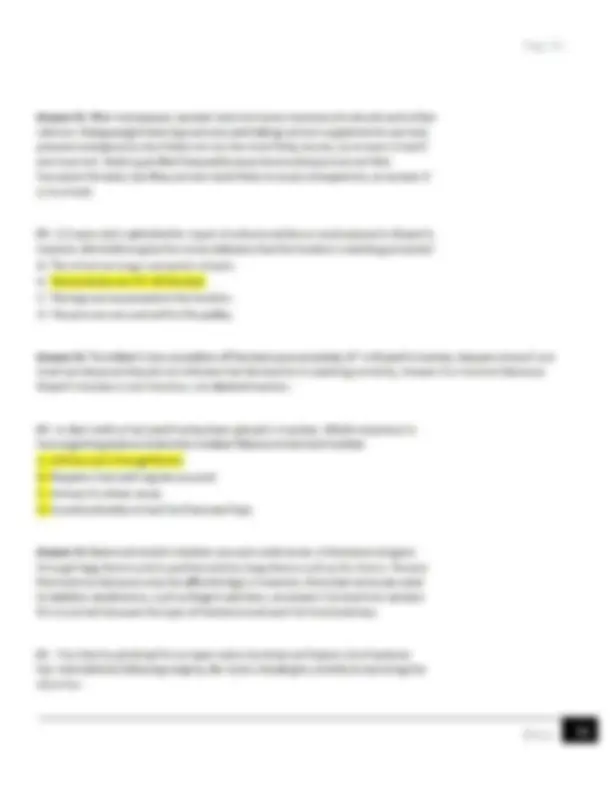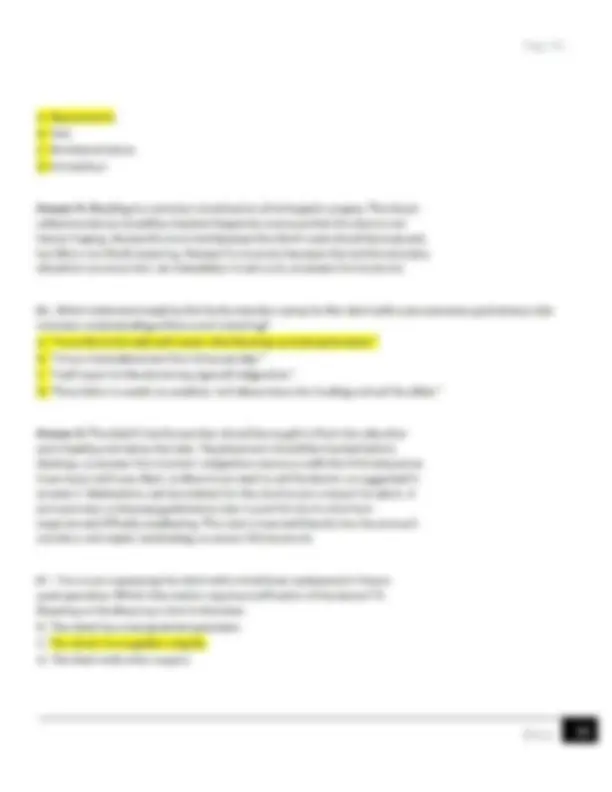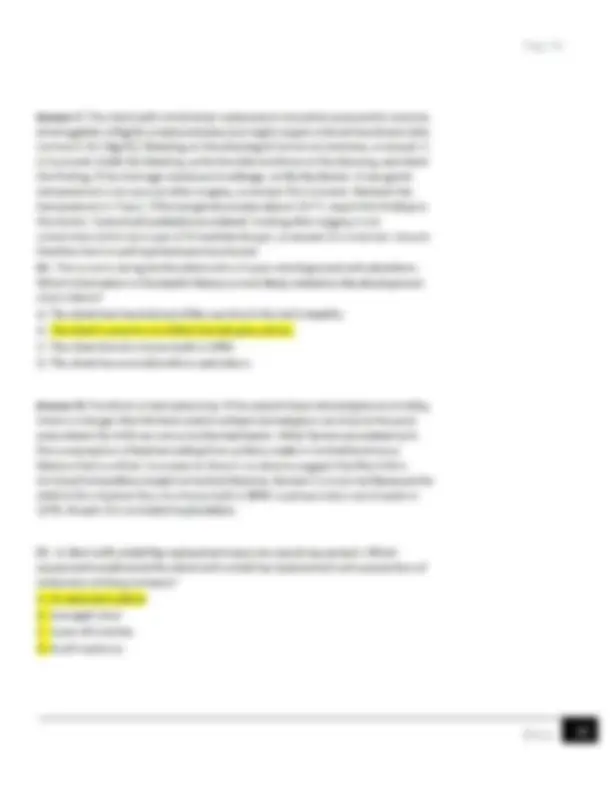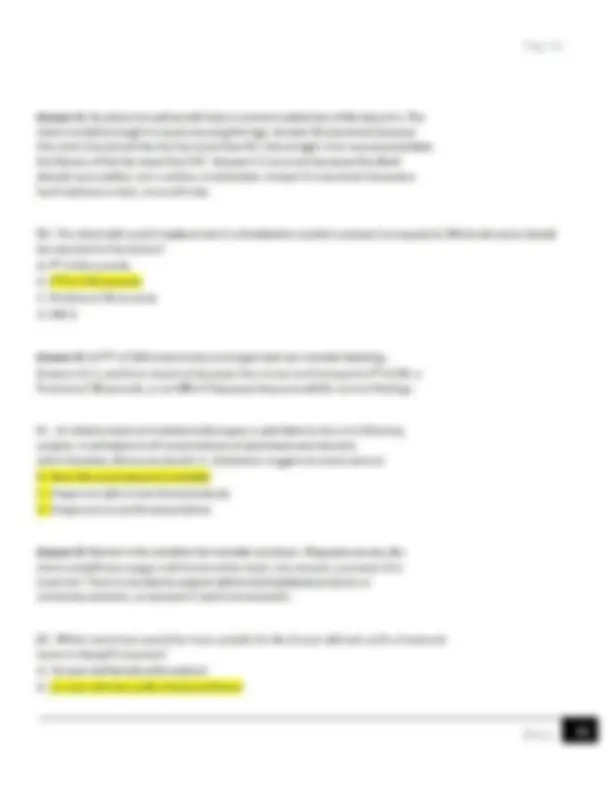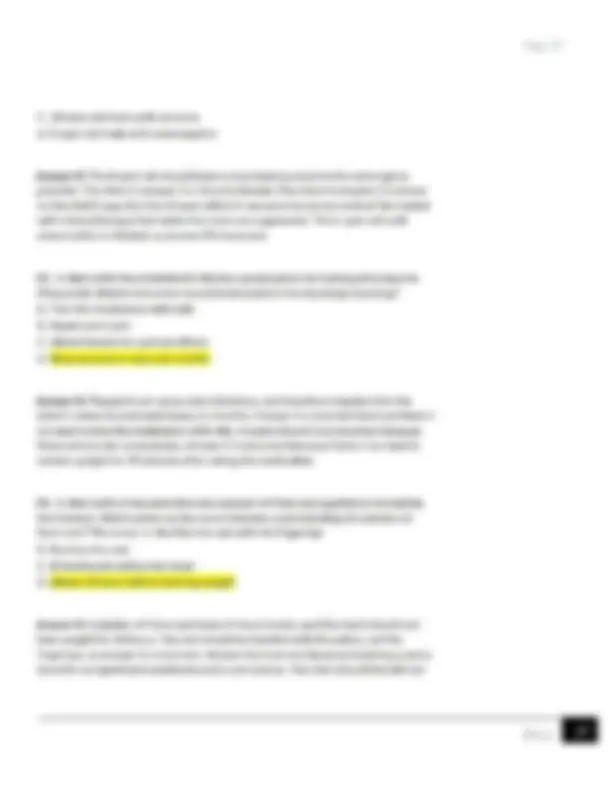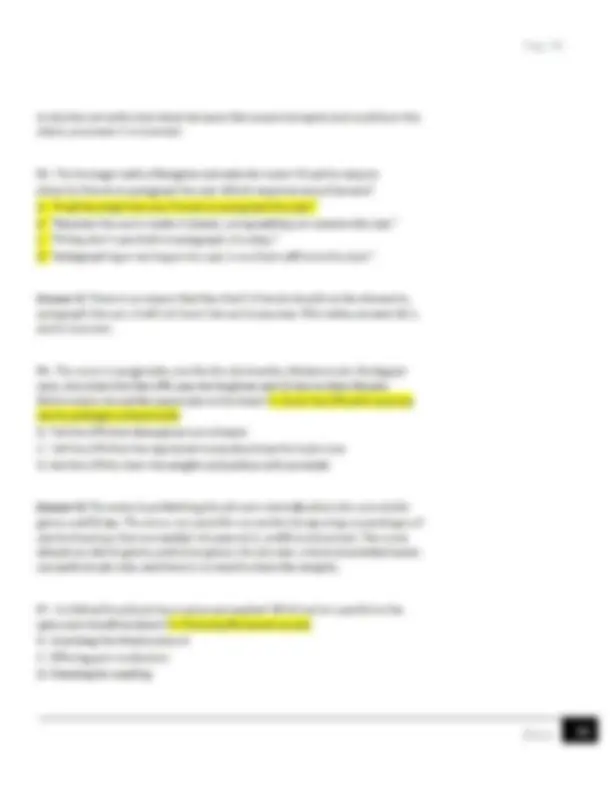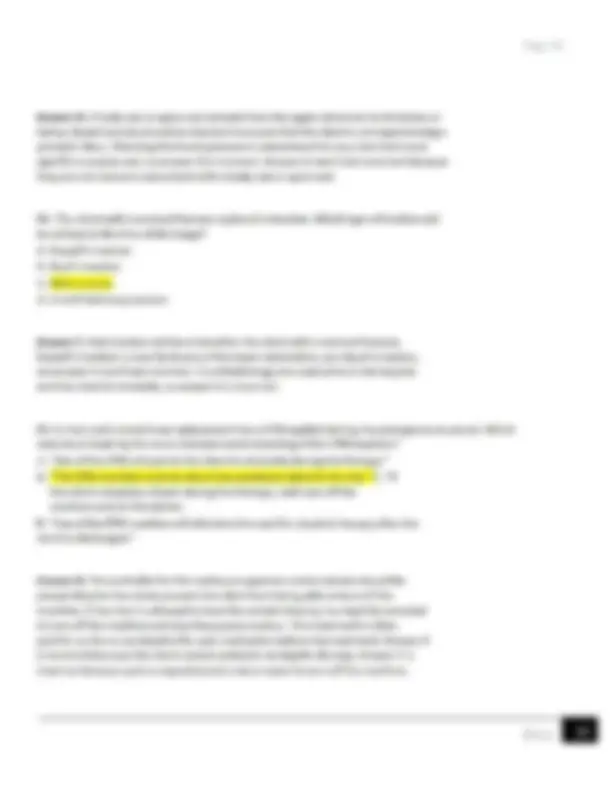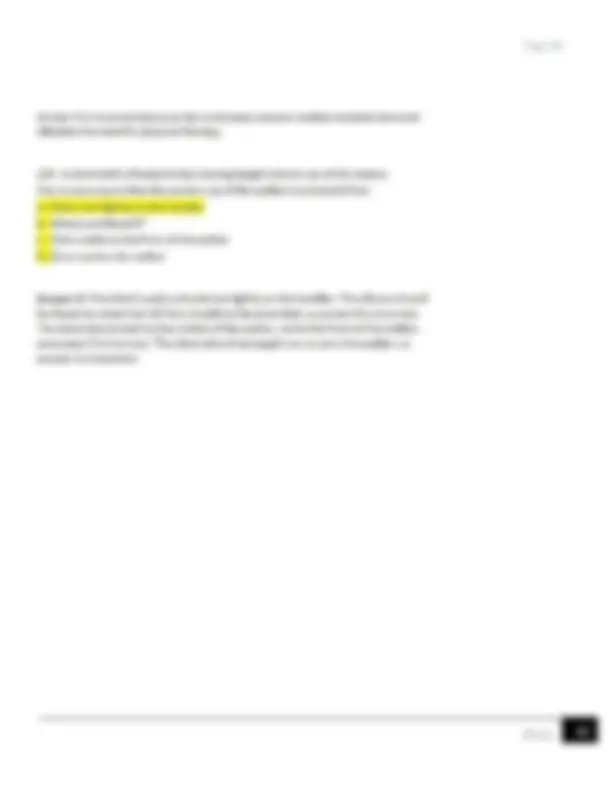Partial preview of the text
Download NCLEX-PN Test Prep Questions and Answers with Explanations and more Exams Nursing in PDF only on Docsity!
V2 PRACTICE EXAM 1 (STUDY MODE) 1.A papular lesion is noted on the perineum of the laboring client. Which initial action is most appropriate? A. Document the finding C. Prepare the client for a C-section D. Continue primary care as prescribed Answer B: Any lesion should be reported to the doctor. This can indicate a herpes lesion. Clients with open lesions related to herpes are delivered by Cesarean section because there is a possibility of transmission of the infection to the fetus with direct contact to lesions. It is not enough to document the finding, so answer A is incorrect. The physician must make the decision to perform a C-section, making answer C incorrect. It is not enough to continue primary care, so answer D is incorrect. 2.Aclient with a diagnosis of human papillomavirus (HPV) is at risk for which of the following? A. Lymphoma B. Cervical and vaginal cancer C. Leukemia D. Systemic lupus Answer B: The client with HPV is at higher risk for cervical and vaginal cancer related to this STI. She is not at higher risk for the other cancers mentioned in answers A, C, and D, so those are incorrect. 3. The client seen in the family planning clinic tells the nurse that she has a painful lesion on the perineum. The nurse is aware that the most likely source of the lesion is: A. Syphilis B. Herpes C. Candidiasis D. Condylomata Answer B: A lesion that is painful is most likely a herpetic lesion. A chancre lesion associated with syphilis is not painful, so answer A is incorrect. In answer C, candidiasis is a yeast infection and does not present with a lesion, but it is exhibited by a white, cheesy discharge. Condylomata lesions are painless warts, so answer Dis incorrect. 4.Aclient visiting a family planning clinic is suspected of having an STI. The most diagnostic test for treponema pallidum is: A. Venereal Disease Research Lab (VDRL) B. Rapid plasma reagin (RPR) C, Florescenttrepanemal antibody (FTA) D. Thayer-Martin culture (TMC) Answer C: FTA is the only answer choice for treponema pallidum. Answers A and B are incorrect because VDRL and RPR are screening tests for syphilis but are not conclusive of the disease; they only indicate exposure to the disease. The Thayer- Martin culture is a test for gonorrhea, so answer D is incorrect. 5. Which laboratory finding is associated with HELLP syndrome in the obstetric client? A. Elevated blood glucose B. Elevated platelet count C, Elevated creatinine clearance D. Elevated hepatic enzymes Answer D: The criteria for HELLP is hemolysis, elevated liver enzymes, and low platelet count. In answer A, an elevated blood glucose level is not associated with HELLP. Platelets are decreased in HELLP syndrome, not elevated, as stated in answer B. The creatinine levels are elevated in renal disease and are not associated with HELLP syndrome, as stated in answer C. Answer C: When the L/S ratio reaches 2:1, the lungs are considered to be mature. The infant will most likely be small for gestational age and will not be at risk for birth trauma, so answer Bis incorrect. The L/S ratio does not indicate congenital anomalies, as stated in answer A, and the infant is not at risk for intrauterine growth retardation, as stated in answer D. 9. Which observation in the newborn of a mother who is alcohol dependent would require immediate nursing intervention? A. Crying B. Wakefulness C. Jitteriness D. Yawning Answer C: Jitteriness is a sign of seizure in the neonate. Answers A, B, and Dare incorrect because crying, wakefulness, and yawning are expected in the newborn. 10. The nurse caring for a client receiving magnesium sulfate must closely observe for side effects associated with drug therapy. An expected side effect of magnesium sulfate is: A. Decreased urinary output C. Absence of knee jerk reflex D. Decreased respiratory rate Answer B: The client is expected to become sleepy, have hot flashes, and experience lethargy. A decreasing urinary output, absence of the knee jerk reflex, and decreased respirations are signs of toxicity and are not expected side effects of magnesium sulfate. Therefore, answers A, C, and D are incorrect. 11. The 57-year-old male client has elected to have epidural anesthesia as the anesthetic during a hernia repair. If the client experiences hypotension, the nurse would: A. Place him in the Trendelenburg position B. Obtain an order for Benedryl C. Administer oxygen per nasal cannula D. Answer D: If the client experiences hypotension after an injection of epidural anesthetic, the nurse should turn him to the left side if possible, apply oxygen by mask, and speed the IV infusion. Epinephrine, not Benedryl, in answer B, should be kept for emergency administration. A is incorrect because placing the client in Trendelenburg position (head down) will allow the anesthesia to move up above the respiratory center, thereby decreasing the diaphragm’s ability to move up and down, ventilating the client. Answer Cis incorrect because the oxygen should be applied by mask, not cannula. 12. Aclient has cancer of the pancreas. The nurse should be mast concerned with which nursing diagnosis? B. Alteration in bowel elimination C. Alteration in skin integrity D. Ineffective individual coping Answer A: Cancer of the pancreas frequently leads ta severe nausea and vomiting. Answers B, C, and D are incorrect because although they are a concern to the client, they are not the priority nursing diagnosis. 13. The nurse is caring for a client with ascites. Which is the best method to use for determining early ascites? A. Inspection of the abdomen for enlargement B. Bimanual palpation for hepatomegaly C. D. Assessment for a fluid wave Answer C: Measuring the girth daily with a paper tape measure and marking the area that is measured is the most objective methad of estimating ascites. Inspection, in answer A, and checking for fluid waves, in answer D, are more subjective and not correct. Palpation of the liver will not tell the amount of ascites, so answer Bis incorrect. 14. The client arrives in the emergency department after a motor vehicle accident. Nursing assessment findings include BP 80/34, pulse rate 120, and respirations 20. Which is the client’s most appropriate priority nursing diagnosis? A. Alteration in cerebral tissue perfusion take. Answer Cis incorrect because asking the visitor to leave and not return until the client’s white blood cell count is 1,000 is an insuffient intervention. The normal WBC is 5,000-— 10 ,000, so a WBC of 1,000 is not high enough to prevent the client from contracting infections. 17. The nurse is caring for the client admitted after trauma to the neck in an automobile accident. The client suddenly becomes unresponsive and pale, with a BP of 60 systolic. The initial nurse’s action should be to: A. Place the client in Trendelenburg position B. Increase the infusion of normal saline C. Administer atropine IM D. Obtain a crash cart Answer B: For some clients with trauma to the neck, the answer would be A; however, in this situation, it is incorrect because lowering the head of the bed could further interfere with the airway. Increasing the infusion and placing the client in supine position is better. If atropine is administered to the client, it should be given IV, not IM, and there is no need for this action at present, as stated in answer C. Answer D is not necessary at this time. 18 . Immediately following the removal of a chest tube, the nurse would : A. Order a chest x-ray B. Take the blood pressure C. Cover the insertion site with a Vaseline gauze D. Ask the client to perform the Valsalva maneuver Answer C: When a chest tube is removed, the hole should be immediately covered with a Vaseline gauze to prevent air from rushing into the chest and causing the lung to collapse. The doctor, not the nurse, will order a chest xray; therefore, answer A is incorrect. Taking the BP in answer B is good but is not the priority action. Answer D is incorrect because the Valsalva maneuver is done during removal of the tube, not afterward. 19 .Aclient being treated with sodium warfarin has an INR of 9.0. Which intervention would be most important to include in the nursing care plan? B. Anticipate an increase in the dosage [Date] | 7] €. Instruct the client regarding the drug therapy D. Increase the frequency of neurological assessments Answer A: The normal international normalizing ratio (INR) is 2-3. A9 might indicate spontaneous bleeding. Answer Bis an incorrect action at this time. Answer Cis incorrect because just instructing the client regarding his medication is not enough. Answer D is incorrect because increasing the frequency of neurological assessment will not prevent bleeding caused by the prolonged INR. 20. Which snack selection by a client with osteoporosis indicates that the client understands the dietary management of the disease? A. Aglass of orange juice B. A blueberry muffin C. Acup of yogurt D. Abanana Answer C: The food with the most calcium is the yogurt. The others are good choices, but not as good as the yogurt, which has approximately 400mg of calcium. Therefore, answers A, B, and D are incorrect. 21. The elderly client with hypomagnesemia is admitted to the unit with an order for magnesium sulfate. Which action by the nurse indicates understanding of magnesium sulfate? A. The nurse places a sign over the bed not to check blood pressures in the left arm. B. The nurse places a padded tongue blade at the bedside. C. The nurse measures the urinary output hourly. D. The nurse darkens the room. Answer C: The client receiving magnesium sulfate should have a Foley catheter in place, and the hourly intake and output should be checked because a sign of toxicity to magnesium sulfate is oliguria. There is no need to refrain from checking the blood pressure in the left arm, as stated in answer A. A padded tongue blade should be kept in the room at the bedside, just in case of a seizure, but this is not related to the magnesium sulfate infusion, so this makes answer B incorrect. Answer D is incorrect because just darkening the room will not prevent toxicity, although it might help with the headache associated with preeclampsia. Answer D: The client with anorexia shows the most improvement by weight gain. Selecting a balanced diet, as in answer A, is of little use if the client does not eat the diet. The hematocrit in answer B is incorrect because although it might improve by several means, such as blood transfusion, it does not indicate improvement in the anorexic condition. The tissue turgor indicates fluid stasis, not improvement of anorexia; therefore, answer Cis incorrect. 25. The client is admitted following repair of a fractured femur with cast application. Which nursing assessment should be reported to the doctor? A. Pain B. Warm toes C. Pedal pulses rapid D. Paresthesia of the toes Answer D: Paresthesia, in answer D, is not normal and might indicate compartment syndrome. At this time, pain beneath the cast is normal, so answer Ais incorrect. The client’s toes should be warm to the touch and pulses should be present. Because answers B and C are normal findings, these answers are incorrect. 26. Which would be an expected finding during injection of dye with a cardiac catheterization? A. Cold extremity distant to the injection site o. Walt the entrain C. Extreme chest pain D. Itching in the extremities Answer B: It is normal for the client to have a warm sensation when dye is injected. Answer Ais incorrect because the client should not have a cold extremity. This indicates peripheral vascular disease. Answer Cis incorrect because extreme chest pain can be related to a myocardial infarction. The pain is not normal. Answer D is incorrect because itching is a sign of an allergic reaction. Also, the itching will most likely be on the chest and skin folds. 27. Which action by the healthcare worker indicates a need for further teaching? A. The nursing assistant wears gloves while giving the client a bath. [Date] | 10 | B. The nurse wears goggles while drawing blood from the client. C. The doctor washes his hands before examining the client. D. The nurse wears gloves to take the client's vital signs. Answer D: It is not necessary to wear gloves to take the vital signs of the client under normal circumstances. If the client has active infection with methicillin- resistant staphylococcus aureus, gloves should be worn. The other answer choices indicate knowledge of infection control by the actions, so answers A, B, and C are incorrect. 28 . The client is having electroconvulsive therapy for treatment of severe depression. Which of the following indicates that the client’s ECT has been effective? A. The client loses consciousness. B. The client vomits. C. The client’s ECG indicates tachycardia. D. The client has a grand mal seizure. Answer D: During ECT, the client will have a grand mal seizure. This indicates completion of the electroconvulsive therapy. Answer A is incorrect because clients are frequently given medication that will cause drowsiness or sleep. Answer Bis incorrect because vomiting is not a sign that the ECT has been effective. Answer Cis incorrect because tachycardia might be present, but it is not asign that the ECT has been effective. 29 .A5-year-old is being tested for pinworms. To collect a specimen for assessment of pinworms, the nurse should teach the mother to: B. Scrape the skin with a piece of cardboard and bring it to the clinic €. Obtain a stool specimen in the afternoon D. Bring a hair sample to the clinic for evaluation Answer A: Infection with pinworms begins when the eggs are ingested or inhaled. The eggs hatch in the upper intestine and mature in 2-8 weeks. The females then mate and migrate out the anus, where they lay up to 17,000 eggs. This causes [Date] 11 poses a risk to the pregnant client because the implant stays with the patient. The client in answer C is radioactive in very small doses. For approximately 72 hours, the client should dispose of urine and feces in special containers and use plastic spoons and forks. The client in answer D is also radioactive in small amounts, especially upon return from the procedure. Thus, answers B, C, and D are all incorrect. 32. Which client should be assigned to a private room if only one is available? B. The client with diabetes C. The client with acromegaly D. The client with myxedema Answer A: The client with Cushing’s syndrome has adrenocortical hypersecretion. This increase in the level of cortisone causes the client to be immune suppressed, and he should not have a raommate because of the possibility of infection. In answer B, the client with diabetes poses no risk to other clients. The client in answer C has an increase in growth hormone and poses no risk to himself or others. The client in answer D has hyperthyroidism or myxedema and so poses no risk to others or himself. 33. The nurse caring for a client on the pediatric unit administers adultstrength Digitalis to the 3-pound infant. As a result of her actions, the baby suffers permanent heart and brain damage. The nurse can be charged with: A. Negligence B. Tort C. Assault D. Malpractice Answer D: Malpractice is failing to perform or performing an act that causes harm to the client, making answer D correct. In answer A, negligence is failing to perform care for the client. In answer B, a tort is a wrongful act committed to the client or his belongings. Answer Cis incorrect because assault is willfully hitting or restraining the client. 34. Which assignment should not be performed by the licensed practical nurse? A. Inserting a Foley catheter [Date] a) B. Discontinuing a nasogastric tube C. Obtaining a sputum specimen Dy Answer D: The licensed practical nurse should not be assigned to begin a blood transfusion. The licensed practical nurse can insert a Foley catheter, as stated in answer A; discontinue a nasogastric tube, as stated in answer B; and collect sputum specimen, as stated in answer C. Thus, answers A, B, and C are all incorrect. 35. The client returns to the unit from surgery with a blood pressure of 90/50, pulse 132, and respirations 30. Which action by the nurse should receive priority? A. Continuing to monitor the vital signs B. Contacting the physician C. Asking the client how he feels D. Asking the LPN to continue the post-op care Answer B: The vital signs are abnormal and should be reported to the doctor immediately. To continue to monitor the vital signs, as in answer A, could result in deterioration of the client’s condition. Asking the client how he feels in answer C will provide only subjective data. The nurse in answer D is not the best nurse to assign because this client is unstable. 36. Which nurse should be assigned to care for the postpartal client with preeclampsia? The nurse with: A. 2 weeks of experience in postpartum B. 3 years of experience in labor and delivery €. 10 years of experience in surgery D.1 year of experience in the neonatal intensive care unit Answer B: The nurse in answer B has the most experience in knowing possible complications involving preeclampsia. The nurse in answer Ais a new nurse to the unit and so should not be assigned to this client; the nurses in answers C and D have no experience with the postpartum client, so neither should be assigned to this client. [Date] 14 C. The 50-year-old with MRSA (methcillin-resistant staphylococcus aurea) D.The Answer D: The client with multiple sclerosis should receive priority because of the IV cortisone treatment. This client is at highest risk for complications. The clients in answers A and Bare more stable and are not the priority. The client with MRSA (methicillin-resistant staphylococcus aureus) is being treated with antibiotics, but there is no data to indicate that the nurse should see this client first, so answer Cis incorrect. 40. The emergency room is flooded with clients injured in a tornado. Which clients can be assigned to share a room in the emergency department during the disaster? A. Aschizophrenic client having visual and auditory hallucinations and the client with ulcerative colitis << G& Achild whose pupils are fixed and dilated and his parents, and a client with a frontal head injury D. The client who arrives with a large puncture wound to the abdomen and the client with chest pain Answer B: The two clients who can share a room are the pregnant client and the client with a broken arm and facial lacerations because these clients are stable. The other clients in answers A needs ta be placed in separate rooms because the schizophrenic will further upset the client with an ulcerative colitis. Answer Cis incorrect because this child is terminal and he should not be placed in the room with the client with a frontal head injury. Answer D is incorrect because the chest pain may be related to a myocardial infarction. 41. The nurse is caring for a 6-year-old client admitted with the diagnosis of conjunctivitis. Before administering eyedrops, the nurse should recognize that it is essential to consider which of the following? B. The child should be allowed to instill his own eyedrops. [Date] | 16 | C. The mother should be allowed to instill the eyedrops. D. ifthe eye is clear of any redness or edema, the eyedrops should be held. Answer A: Before instilling eyedraps, the nurse should cleanse the area with water. A6-year-old child is not developmentally ready to instill his own eyedrops, so answer B is incorrect. Although the mother of the child may instill the eyedrops, the area must be cleansed before administration, so answer C is incorrect. The eye might appear to be clear, but the nurse should instill the eyedrops, as ordered, so answer Dis incorrect. 42. The nurse is discussing meal planning with the mother of a 2-year-old toddler. Which of the following statements, if made by the mother, would require a need for further instruction? A. “It is okay to give my child white grape juice for breakfast.” B. “My child can have a grilled cheese sandwich for lunch.” C. “Weare going on atrip, and | have bought hot dogs to gril for his lunch.” D. “Forasnack, my child can have ice cream.” Answer C: The comment of most concern is answer C because hot dogs are commonly the cause of choking in children. There is no reason for concern in the comments in answers A, B, or D; therefore, these are incorrect. 43. A 2-year-old toddler is seen in the pediatrician’s office. During physical assessment, the nurse would anticipate the need for which intervention? A. Ask the parent/guardian to leave the room when assessments are being performed B. Ask the parent/guardian to remove the child’s toys during exa c. D. If the child is screaming, tell him this is inappropriate behavior Answer C: There is no reason to tell the parents to leave because this might cause the child to become more agitated, making answer A incorrect. Removing his toys may also cause him to fret and make the examination more difficult, so answer B [Date] 17 D. Vomiting and diarrhea Answer A: If the child has bacterial pneumonia, a high fever is usually present. Bacterial pneumonia usually presents with a productive cough, not a nonproductive cough, so answer B is incorrect. Rhinitis is often seen with viral pneumonia, not bacterial pneumonia, so answer Cis incorrect. Vomiting and diarrhea are usually not seen with pneumonia, so answer Dis incorrect. 47. The nurse is caring for a client admitted with acute laryngotracheobronchitis (LTB). Because of the possibility of complete obstruction of the airway, which of the following should the nurse have available? A. Intravenous access supplies B. Emergency intubation equipment C. Intravenous fluid administration pump D. Supplemental oxygen Answer B: For achild with LTB and the possibility of complete obstruction of the airway, emergency intubation equipment should always be kept at the bedside. Intravenous supplies and fluid will not treat an obstruction, so answers A and C are incorrect. Answer D is incorrect because although supplemental oxygen is needed, the child will need to be intubated for it to help. 48 . The 45-year-old client is seen in the clinic with hyperthyroidism. What would the nurse expect the admitting assessment to reveal? A. Bradycardia B. Decreased appetite C. Exophthalmos D. Weight gain Answer C: Exophthalmos (protrusion of eyeballs) often occurs with hyperthyroidism. The client with hyperthyroidism will often exhibit tachycardia, increased appetite, and weight loss, not bradycardia, decreased appetite, or weight gain, so answers A, B, and D are incorrect. [Date] | 19 | 49 . The nurse is providing dietary instructions to the mother of an 8-year-old child diagnosed with celiac disease. Which of the following foods, if selected by the mother, would indicate her understanding of the dietary instructions? A. Whole-wheat bread B. Spaghetti and meatballs C. Hamburger on white bread with ketchup D. Cheese omelet Answer D: The child with celiac disease should be on a gluten-free diet. Answer D is the only choice of foods that do not contain gluten, so answers A, B, and Care incorrect. 50. The nurse is caring for a 9-year-old child admitted with asthma. During the morning rounds, the nurse finds an Q2 sat of 78%. Which of the following actions should the nurse take first? A. Check the arterial blood gases. B. Do nothing; this is a normal O2 sat for this client. c D. Assess the child’s pulse. Answer C: The child with an oxygen saturation level of 78% is hypoxic. He will require oxygen therapy. Checking the arterial blood gases in answer A is good but is not the highest priority and will not correct the problem. If the nurse does nothing, as in answer B, the client’s condition will most likely continue to decline. Answer Dis incorrect because assessing the pulse will probably reveal tachycardia, but this is not the highest priority. 51.A gravida II para 0 is admitted to the labor and delivery unit. The doctor performs an amniotomy. Which observation would the nurse expect to make after the amniotomy? A. Fetal heart tones 160bpm CA small amount of greenish fluid DA small segment of the umbilical cord Answer B: Normal amniotic fluid is straw colored and odorless. An amniotomy is an artificial rupture of membranes. Fetal heart tones of 160 indicate tachycardia, so [Date] | 20 | 

